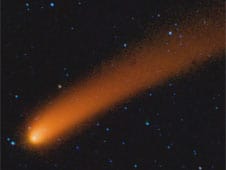

A diverse cast of cosmic characters is showcased in the first images NASA released last week from its Wide-field Infrared Survey Explorer, or WISE, an automated infrared telescope in Earth orbit.
Since WISE began its scan of the entire sky in infrared light on Jan. 14, this orbiting telescope has beamed back more than a quarter of a million raw (unprocessed) infrared images. Four new, processed pictures illustrate a sampling of the mission’s targets—a wispy comet, a bursting star-forming cloud, the grand Andromeda galaxy, and a faraway cluster of hundreds of galaxies.
The images are online at:
http://www.nasa.gov/mission_pages/WISE/multimedia/images20100216.html
“WISE has worked superbly,” said Ed Weiler, associate administrator of the Science Mission Directorate at NASA Headquarters in Washington, D.C. “These first images are proving that the spacecraft’s secondary mission of helping to track asteroids, comets and other stellar objects will be just as critically important as its primary mission of surveying the entire sky in infrared.”
One image shows the beauty of a comet called Siding Spring. As the comet parades toward the Sun, it sheds dust that glows in infrared light visible to WISE. The comet’s tail, which stretches about 10 million miles, looks like a streak of red paint. A bright star appears below it in blue.
“We’ve got a candy store of images coming down from space,” said Edward (Ned) Wright of UCLA, the principal investigator for WISE. “Everyone has their favorite flavors, and we’ve got them all.”
During its survey, the mission is expected to find perhaps dozens of comets, including some that ride along in orbits that take them somewhat close to Earth’s path around the Sun. WISE will help unravel clues locked inside comets about how our solar system came to be.
Another image shows a bright and choppy star-forming region called NGC 3603, lying 20,000 light-years away in the Carina spiral arm of our Milky Way galaxy. This star-forming factory is churning out batches of new stars, some of which are monstrously massive and hotter than the Sun. The hot stars warm the surrounding dust clouds, causing them to glow at infrared wavelengths.
WISE will see hundreds of similar star-making regions in our galaxy, helping astronomers piece together a picture of how stars are born. The observations also provide an important link to understanding violent episodes of star formation in distant galaxies. Because NGC 3603 is much closer, astronomers use it as a lab to probe the same type of action that is taking place billions of light-years away.
“All these pictures tell a story about our dusty origins and destiny,” said Peter Eisenhardt, the WISE project scientist at JPL. “WISE sees dusty comets and rocky asteroids tracing the formation and evolution of our solar system. We can map thousands of forming and dying solar systems across our entire galaxy. We can see patterns of star formation across other galaxies, and waves of star-bursting galaxies in clusters millions of light years away.”
Other mission targets include comets, asteroids and cool stars called brown dwarfs. WISE discovered its first near-Earth asteroid on Jan. 12 and its first comet on Jan. 22. The mission will scan the entire sky one-and-a-half times by October 2010. At that point, the frozen coolant needed to chill its instruments will be depleted.
You can meet Bob Eklund at his website, www.bobeklund.com – Reprinted with thanks to the Mountain View News.





Be the first to comment